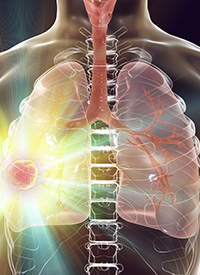Sotorasib Plus SHP2 Inhibition Elicits Promising Preliminary Activity in KRAS G12C–Mutated NSCLC
The combination of sotorasib and the small molecule SHP2 inhibitor RMC-4630 led to an investigator-assessed objective response rate of 27% and 50% in pretreated and KRAS G12C inhibitor–naïve patients with non–small cell lung cancer, respectively.

The combination of sotorasib (Lumakras) and the small molecule SHP2 inhibitor RMC-4630 led to an investigator-assessed objective response rate (ORR) of 27% (95% CI, 6%-61%) and 50% (95% CI, 12%-88%) in pretreated and KRAS G12C inhibitor–naïve patients with non–small cell lung cancer (NSCLC), respectively, according to findings from a phase 1b trial (NCT04185883).
The data, which were presented at the International Association for the Study of Lung Cancer (IASLC) 2022 World Conference on Lung Cancer, showed that among all enrolled patients with NSCLC (n = 11) who received the regimen, 3 experienced partial responses (PRs; 27%), 4 had stable disease (SD; 36%), and 4 experienced progressive disease (PD; 36%); this translated to a disease control rate (DCR) of 64% (n = 7). Within the KRAS G12C inhibitor–naïve population (n = 6), 3 PRs (50%) and 3 cases of SD (50%) were reported, translating to a DCR of 100%.
“Preclinical rationale and putative mechanisms of resistance support the combination of sotorasib with a SHP2 inhibitor,” Gerald S. Falchook, MD, director of the Sarah Cannon Research Institute at HealthONE, and coauthors, stated in the presentation. “The combination of sotorasib with a SHP2 inhibitor, RMC-4630, based on early data, appears safe and well tolerated in KRAS p.G12C–mutated solid tumors. Additionally, promising and durable clinical activity was observed in patients with NSCLC, most notably in those who were KRAS G12C inhibitor naïve.”
Sotorasib is a specific and irreversible KRAS G12C inhibitor approved for the treatment of patients with previously treated KRAS G12C–mutated NSCLC. However, genomic alterations in the RTK pathway have been linked to acquired resistance mechanisms to the agent.
In mouse xenograft models, the addition of sotorasib to a SHP2 inhibitor reduced RTK signaling to RAS and enhanced antitumor activity.
The multicenter, open-label study enrolled patients with locally advanced or metastatic KRAS G12C–mutated solid tumors. Within the NSCLC cohort, patients must have received prior therapy with PD-1/PD-L1 inhibitors and/or platinum-based chemotherapy and targeted therapy. Treatment with a prior KRAS G12C inhibitor was allowed across all cohorts.
Part 1 consisted of the dose-exploration phase in which 27 patients received 960 mg of sotorasib once daily plus RMC-4630 in escalating weekly doses starting at 100 mg on days 1 and 2 or days 1 and 4 (n = 6), then 140 mg on days 1 and 2 (n = 10), and 200 mg on days 1 and 2 (n = 11).
The primary end points comprising safety included the identification of dose-limiting toxicities (DLTs), treatment-related adverse effects (TRAEs) and treatment-emergent AEs, as well as changes in vital signs, ECGs, and clinical laboratory tests. Secondary efficacy end points included the evaluation of pharmacokinetics, ORR, duration of response (DOR), time to response, DCR, duration of SD per RECIST v1.1 criteria, and overall survival.
The data cutoff was April 11, 2022, allowing for a median follow-up of 5.8 months.
Within the NSCLC cohort, the median age was 64 years (range, 51-78), 36% of patients (n = 4) were male, and all were prior smokers. Most patients had an ECOG performance status of 0 (n = 10; 90%). The most common site of metastasis was the brain (n = 7; 64%) followed by the liver (n = 3; 27%).
The median number of prior lines of therapy received was 3 (range, 1-6). Almost all patients had received a prior PD-1/PD-L1 inhibitor (n = 10; 91%), and approximately half (n = 5; 45%) had received a prior KRAS G12C inhibitor.
The median duration of treatment on the combination was 3.1 months (standard deviation, 2.7). At the time of data cutoff, 2 of 3 patients in PR had an ongoing response, with a DOR of more than 9.8 months and 6.9 months, respectively.
Additionally, 1 patient whose disease progressed on prior sotorasib experienced more than 30% tumor shrinkage at 5.5 months, with PD at 6.9 months.
“There were no clinically meaningful drug-drug interactions between sotorasib and RMC-4630, and the average sotorasib and RMC-4630 exposures were consistent with distributions observed in monotherapy studies,” the authors wrote.
Notably, at the two highest doses of RMC-4630, responders included 3 of 4 patients who were KRAS G12C inhibitor naïve.
Regarding safety, the most common TRAEs with the combination across the entire study population were edema (all grade, 30%), diarrhea (all grade, 26%; grade 3, 7%), dry mouth (all grade, 11%), fatigue (all grade, 11%), aspartate aminotransferase increase (all grade, 7%; grade 3, 4%), ascites (all grade, 4%; grade 3, 4%), colitis (all grade, 4%; grade 3, 4%), dyspnea (all grade, 4%; grade 3, 4%), hypertension (all grade, 4%; grade 3, 4%), and pleural effusion (all grade, 4%; grade 3, 4%).
“Sotorasib combined with RMC-4630 was safe and tolerable, with no grade 4 or fatal TRAEs and few TRAE-related discontinuations,” the authors wrote. “TRAEs were consistent with the known safety profile of sotorasib and RMC-4630. Edemas (peripheral and facial) were the most common TRAE; all were grade 1 or 2, and none led to discontinuation.
Across the 100-mg, 140-mg, and 200-mg dosing cohorts, TRAEs leading to sotorasib dose modification occurred in 17% (n = 1), 10% (n = 1), and 27% (n = 3) of patients, respectively; dose modifications with RMC-4630 occurred in 33% (n = 2), 10% (n = 1), and 36% (n = 4) of patients, respectively.
One patient each in the 100-mg and 140-mg cohorts experienced a DLT.
The combination is under further study in a phase 2 trial (NCT05054725) in patients with metastatic NSCLC who are KRAS G12C inhibitor naïve.
Reference
Falchook GS, Li BT, Marrone KR, et al. Sotorasib in combination with RMC-4630, a SHP2 inhibitor, in KRAS p.G12C-mutated NSCLC and other solid tumors. Presented at: IASLC 2022 World Conference on Lung Cancer; August 6-9, 2022; Vienna, Austria. Abstract OA03.03



